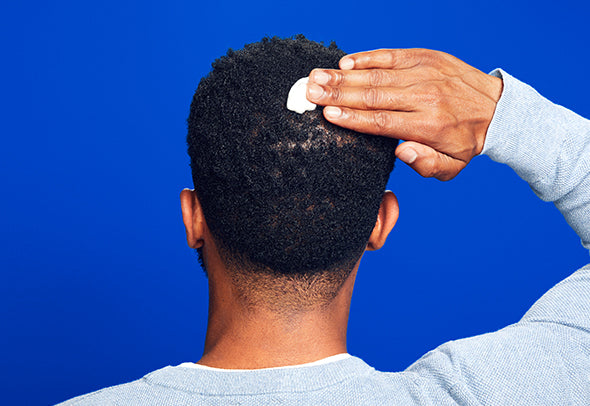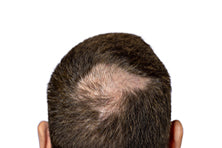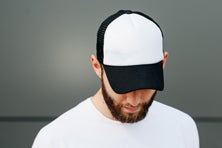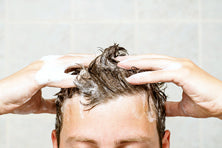Losing your hair is one of those things that many men fear about getting older. And while for most men hair loss isn’t anything to be worried about, a thinning hairline or balding crown can impact your confidence and how you feel.
The gradual, genetic hair loss that many men experience as they get older is called male pattern baldness or androgenic alopecia. It’s so common that by the age of 50 half of all men will experience some hair loss.
So, if you’re dealing with hair loss from male pattern baldness, we’re here to help you feel informed and in control. Read on to learn about the symptoms, causes and effective treatments.
Male Pattern Baldness Symptoms
What is considered a normal amount of hair loss per day for males? The average scalp is covered with 100,000 hair follicles. While most people lose between 50-100 hairs a day, a consistent loss of 150 hairs or more a day is considered significant hair loss.
As well as noticing a change in your hairline or hair density, there are some other clues that may suggest more hair loss than usual:
- Finding hair on your pillow
- More strands in your brush or comb than usual
- More hair in the drain
- Sunburn on thinning spots on your scalp
While age is a factor in hair loss, don’t be alarmed if you’re still young when you notice symptoms like thinning at the crown. Male pattern baldness can start as early as your teens or early twenties1.
What Causes Hair Loss in Men?
Male pattern baldness or male pattern hair loss is the common name for a condition called androgenic alopecia, and it is by far the most common cause of hair loss in men. In fact, male pattern baldness is the cause of 95% of all male hair loss.
A combination of hereditary hair loss factors, hormone activity, and age result in the shortening of the hair growth cycle and gradual shrinking of hair follicles. This means that each growth cycle produces a shorter, finer, much-less-visible hair. In time, some follicles become incapable of producing visible hair at all.
Factors Affecting Male Pattern Baldness:
Family History:
Hereditary hair loss can come from either your mother’s or father’s side of the family, so looking to the generations above you may give you a clue into your family’s hair loss trends.
Hormonal Hair Loss in Men:
The male hormone testosterone and one of its byproducts DHT are known to have an impact on the hair follicles. Fluctuations in these androgens (male hormones) over time may be a factor in male pattern hair loss.
Aging & Hair Loss:
Hair thinning can be very gradual, so it’s no wonder that age is a factor affecting male pattern baldness. The effect of genetic factors and hormones on your hair follicles will increase over time, meaning that hair loss is often more noticeable in older men.
How to Grow Thicker, Fuller Hair
While there are plenty of hairstyles or haircuts to help hide your receding hairline or thinning hair, there are also over the counter hair loss treatments available to regrow thinning hair. Minoxidil, the active ingredient in ROGAINE®, is an effective treatment that reactivates the hair follicles on your scalp so you can regrow thicker, fuller hair.
ROGAINE® and its active ingredient minoxidil, are the only FDA approved topical treatment. It is the only treatment approved for over-the-counter use.
Twice-daily application with either the ROGAINE® 5% Minoxidil Solution or ROGAINE® 5% Minoxidil Unscented Foam is clinically proven to boost hair growth regrowth. In fact, in clinical studies nearly 9 out of 10 men noticed results after using ROGAINE®*. When using minoxidil for male pattern hair loss, consistency is key. You can expect results within 3-6 months, and continued use is necessary to improve and maintain hair regrowth.
If you’ve noticed the symptoms of male pattern baldness, try ROGAINE® minoxidil products to boost your follicles and regrow thicker, fuller hair. Explore the range of ROGAINE® products for men, and give your receding or thinning hair a boost with this clinically-proven, effective hair regrowth treatment.
* In a 4-month clinical study (n=352) of twice daily use of Men's ROGAINE® Foam vs. Placebo
Sources
- Asfour L, Cranwell W, Sinclair R. Male Androgenetic Alopecia. [Updated 2023 Jan 25]. In: Feingold KR, Anawalt B, Blackman MR, et al., editors. Endotext [Internet]. South Dartmouth (MA): MDText.com, Inc.; 2000-. Available from: https://www.ncbi.nlm.nih.gov/books/NBK278957/
- Paula Ludman, MS. What is male pattern hair loss, and can it be treated?. (2022, December 13). American Academy of Dermatology Association. https://www.aad.org/public/diseases/hair-loss/treatment/male-pattern-hair-loss-treatment.
- DHT (Dihydrotestosterone). (2022, December 20). Cleveland Clinic. (https://my.clevelandclinic.org/health/articles/24555-dht-dihydrotestosterone).
- 6 SIGNS OF LOW TESTOSTERONE. (2017, September 19) Eric K. Diner, MD. (https://dinerroboticurology.com/blog/low-testosterone/6-signs-of-low-testosterone/).













